DESIGNS ON GARDENING
/11 Comments/in Design, Gardening, Tools, Vegetables/by Lee ReichThe Turn Of The Year
Sure there’s seed-sowing, weeding, and pruning to do, but I’ve also been spending a good amount of time communing with my pitchfork. Turning compost.
Some people are put off by the thought of having to turn compost. Don’t be. Compost does not have to be turned. Any pile of organic materials will eventually become compost.
Still, I like to turn my composts. I typically build new piles (a lot of them!!) through summer into fall, turn them the following spring, and then spread the finished compost that fall or the following spring. As I fork the ingredients from the old pile into the adjacent bin, I break up any clumps with the pitchfork and fluff up any parts that seem sodden and gasping for air. A nearby hose makes it convenient to spray any dry areas.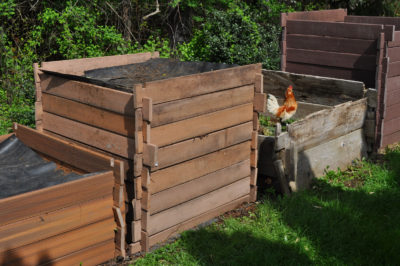
Everything organic (was once or is living) — hay, weeds, old plants, some horse manure, old cotton clothes, vegetable trimmings — goes into my compost, and that includes, unavoidably, weed seeds. Turning my compost pile exposes weed seeds buried within the pile to light, which prompts them to germinate — only to be snuffed out as they are again buried in the turned pile.
I take note of the progress of the decomposition, generally tossing any less decomposed pitchforkfuls towards the more active center of the turned pile. I also “take note” very literally, writing down a rough estimate of how far along the compost has progressed. If it’s, say, 80% finished, it should be ready for use, if needed, within a month or so. If 60% finished, it’ll have to keep cooking until fall.
I like to watch the results of the bacteria, fungi, and other compost pets nurtured within the piles. And turning them is good exercise.
Design Ultimatum
Over the years, my compost bins have gone through many incarnations as I, each time, came up with what I thought was the ultimate design for the bin itself. The present design has retained that status for a number of years now.
The present bin is made of notched boards, 24 per pile, each about 1” thick by 6” wide by 4 feet long. The boards stack up to make a cube Lincoln-log style. For a thorough enclosure, two boards ripped to half their width make up two sides of the bottom of the bin. The advantage of the notched boards is that all four sides are enclosed and the compost bin can be built higher and higher, as needed, as material is added. And lowered, in steps, as finished compost is being removed for spreading, or half-finished compost is being removed for turning into a expanding, adjacent bin.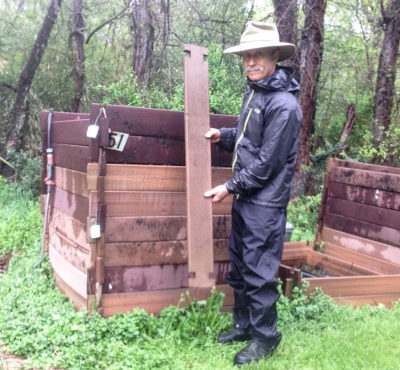
My original “ultimate design” bins were made from wood, which needed replacement every 8 to 10 years. Present bins are made from artificial wood decking, which should hold up forever.
While not a necessity for making compost, a bin does keep everything neat and tidy, keeps scavenging animals and wind-blown weed seeds at bay, and retains heat and moisture for quicker and more thorough composting. As I wrote a few paragraphs earlier, “Any pile of organic materials will eventually become compost.”
Transplant Design
Speaking about good design . . . With so many transplants to water, any method of automatic watering is a godsend. Right now, a couple of hundred of my seedlings are growing in individual, plastic cells sitting on capillary mats. As soil dries out in the cells, it sucks up water from the capillary mat which, in turn, draws water from the reservoir below it. This, the APS system, works very well.
And now an even better design has come down the pike, one made out of terra cotta that, unless dropped, is sure to outlast plastic systems. Cells for a tray of Orta Seed Pots are all housed together in an attached reservoir. One advantage of this design is that cells absorb water throughout their terra cotta walls. Another advantage is that each cell has a drainage hole, so periodic top watering can leach out excess minerals that can build up in pots watered from below.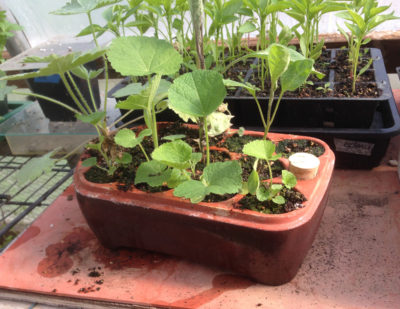
The only downside to Orta Seed Pots is that they are expensive. Then again, they can potentially last forever, and they grow very good plants. The design is so elegant and effective (as borne out by some seedlings that I raised in Orta’s) that I’m going to shamelessly help in their promotion with a link, (www.ortakitchengarden.com/factory-seconds-sale/),to discounted factory seconds, which work perfectly but have cosmetic flaws, or, till the end of May, discounted firsts (www.ortakitchengarden.com), with discount code ORTAMAY).
GRAPE EXPECTATIONS
/5 Comments/in Fruit, Gardening, Pruning, Soil/by Lee ReichHello Vanessa
A few days ago was the perfect day for planting the Vanessa grape vine deposited here by the UPS guy. Not because the weather was warm and sunny or because working outdoors was made all the more pleasant with peach, pear, and plum trees in all their glory, awash in white or pink blossoms. And not because the plums were suffusing the air with a most delectable fragrance.
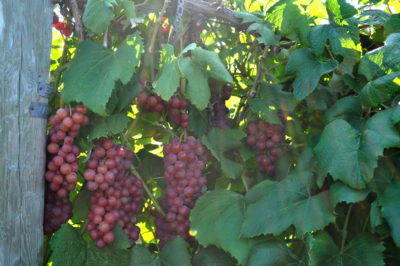
Vanessa grape
The day was perfect for planting because the soil was in such good tilth. With each shovelful, clumps of soil broke apart under their own weight. A far cry from decades ago in my first garden, around this time of year, when digging brought up clods of Wisconsin soil still sticky and wet.
In wet soil, digging drives air out of the soil; under such conditions, roots of trees, shrubs, vines, and seedlings suffer. Better to wait for the soil to dry before planting. But not too long. Soil that is too dry turns rock-hard, too hard to crumble into small pieces to sift amongst roots. All this is moot in sandy soils, which never hold enough water to make them too wet for planting. 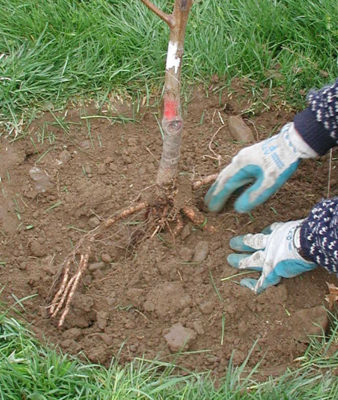
My present ground is a clay loam, which could be poor for planting if too wet. It wasn’t, because, first of all, it hadn’t rained for a few days. Second, warm weather had warmed the soil, the warmth speeding downward movement of excess water. And third, years and years of mulching with leaves, hay, and compost had made the ground rich in organic matter whose goodness had worked its way down through the soil profile with the help of earthworms and other soil organisms, rain, and the action of alternate freezing and thawing. Organic matter, among other benefits, acts as a glue to aggregate soil particles into a crystalline-like structure that helps with holding both air and water.
Training And Pruning Plans
I can bank on Vanessa growing well her first season in the ground. Soon after she arrived, bare-root, I had her roots plumping up with a day-long soak in water. Her planting hole was just deep enough to let her sit at the same depth as in the nursery, and one-and-a-half to twice the spread of the roots across. I clipped back a couple of long, straggly roots.
Holding the stem with one hand, I pushed the soil I had dug out of the hole back in amongst the roots, working it in with my fingertips after initially sifting soil in among the smaller roots by bouncing the plant up and down a little. With the roots nestled into their planting hole, I sprinkled a couple of gallons of water to further settle the soil and get the plant off to a good start.
She arrived with five strong-looking canes jutting up just above where her roots splayed out. Too many, for my purposes. Like her established neighbors, Vanessa will be trained to a “high wire double cordon spur pruned” system, a mouthful that sounds more complicated than it is. Two trunks will rise, unbranched, to about 6 feet in height to the middle wire of a five-wire trellis. One trunk will continue its journey horizontally along the middle wire in one direction; the extension of the other trunk will do likewise in the opposite direction. These two horizontal growths are permanent fixtures, called cordons (same root as the word “cord”). 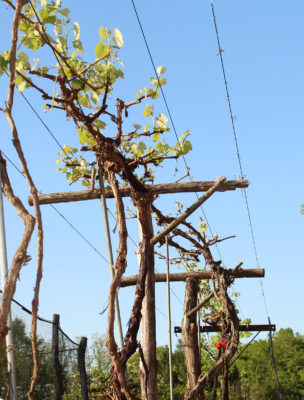
Grapes bear fruits on one-year old stems — these are the so-called “canes,” easily identified by their smooth, reddish brown bark and roughly pencil-thickness. New shoots growing from buds on canes bear bunches of grapes and can drape on the remaining wires on either side of the middle wire.
The following year, the new shoots become one-year-old canes. Without pruning (or with incorrect pruning), fruiting shoots and canes each year move further and further away from the cordon, so I cut each cane back to 2 buds in winter and, after a few years, cut them all the way back, to be replaced by new canes that are always popping out right from the cordon.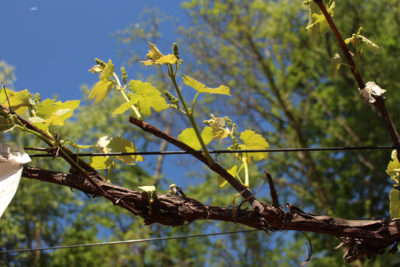
But all this is in Vanessa’s future. This year, all I want from her is two strong trunks.
Don’t Do What I Did
Rain fell, and I didn’t follow my own advice. Because I needed to convert a lumpy old garden area next door to lawn, and because lawngrass establishes best in cool weather, and because I had two helpers coming in a few days to help with ground preparation, I readied the area with a rototiller. I did so even though rain had been falling all day long. Rain fell even while I was tilling.
All in all, it was a horrible experience. Mud everywhere. Wrestling the tiller. Loud engine chugging away. (Now I remember one reason for my book, Weedless Gardening. Weed-less-ness comes, in part, from dispensing with tilling, which awakens buried weed seeds by exposing them to light. And there’s the added benefit of not having to till.)

Youthful, foolish Lee, tilling
With good drainage, the job finally got done without excessive destruction of soil structure. And anyway, I was only planting lawngrass.
A BETTER BERRY?
/8 Comments/in Fruit, Gardening/by Lee ReichOut With The Old, In With The New
“Doubtless God could have made a better berry, but doubtless God never did,” wrote a Dr. Boteler about the strawberry (as quoted in Izaak Walton’s 17th century classic The Compleat Angler). I disagree. I also don’t like to crawl for my fruit. With that said, I’ll agree that strawberries do taste very good, more so for being, usually, the first fruits of the season.
I just took a look at my strawberry bed; weeds are making inroads and the plants look pretty puny. Dispatching the weeds is no problem. As far as the puny plants, it was to be expected. Although strawberries are perennial plants, over time they pick up diseases, including some virus diseases lacking dramatic symptoms except that they reduce productivity. So a strawberry bed should be replanted — at a new location — every 5 years. My garden notes tell me my strawberry bed is 8 years old.

My strawberry bed in its prime
Strawberries send out shoots, called runners, at the ends of which develop new plants which, in turn, send out runners that also develop new plants, ad infinitum. So an untended bed can become very weedy, with strawberries. Even a well-tended bed sneaks in a few extra plants here and there. None of these plants should be used to start a new strawberry bed! Viruses are systemic, so all these new plants will also carry any virus infection.
I’ll be ordering my new strawberry plants from a nursery that sells certified disease and virus free strawberry plants. Then, at least, the plants start off “clean.”
The Best Berry Of All
If I had authored that quote by Dr. Boteler, I would have applied it to highbush blueberries. Not only are they, in my opinion, the best tasting berry, but the plants are truly perennial, remaining productive for 50 years or more. And I can harvest them standing up.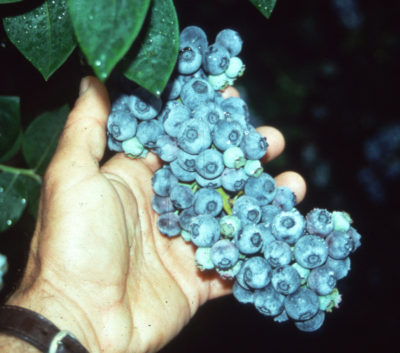
No one is sure just how long a blueberry bush will thrive because they haven’t been cultivated for very long. It was only about a hundred years ago that Dr. Frank Coville of the USDA started studying blueberries in an effort to learn how to grow them. Previous to that, harvests were from wild plants. Even 50 years ago, fresh blueberries rarely appeared on grocer’s shelves.
Of Strawberries And Intrigue
Strawberries, also, have come into cultivation relatively recently, in this case over the past 200 years. Garden strawberries, that is, which owe their origin to a chance mating of two American species of strawberry in a garden in France.
One parent of the modern garden strawberry is the Virginia strawberry of eastern North America. Plants of this tasty, small-fruited species were brought over to Europe and planted in gardens there as early as the 17th century.
Intrigue enters the story in the arrival of the other parent of the modern, garden strawberry, the Chilean strawberry, to Europe. Moving the clock forward to the beginning of the 18th century, we find the French King Louis XIV needing a spy to observe Spanish fortifications in Concepcion, Chile. For this task, he chooses Amédée Francois Frezier, a young lieutenant colonel who had already distinguished himself with an aptitude for foreign languages and science. Amédée set sail on an armed merchant marine ship in 1712.
Upon his arrival in Concepcion, Chile, Amédée posed as a merchant marine captain, which enabled him to visit Spanish fortifications as a tourist. Secretly, he kept notes and made sketches of ammunition stores and escape routes. Besides military reports, Amédée also wrote about the indigenous peoples, the physical geography, and agriculture of the region. One of the plants that caught the lieutenant colonel’s fancy was the Chilean strawberry, which bore fruits larger than those that were known in Europe. Amédée included descriptions and sketches of the Chilean strawberry in his notes, and when it finally came time to leave Chile in 1714, he packed up five plants to smuggle back for his return voyage.
The marriage of the two species finally took place in a strawberry field near Brest, France as a bee carried pollen from the flower of a Virginia strawberry to the female flower of a Chilean strawberry. A seed from the fruit that developed germinated and grew into a plant that was the first modern, hybrid strawberry, combining the large size of one with the high flavor and intense red color of the other.
Better Strawberries
Since Dr. Boteler and Izaak Walton were writing in the 17th century, that “better berry” to which they referred could not have been the modern, garden strawberry. But other species were enjoyed before the modern species came into being: the alpine strawberry (Fragaria vesca), and the musk strawberry (Fragaria moschata). Both species yield delectable, though small, fruits, and are still available today. I’ve grown both.
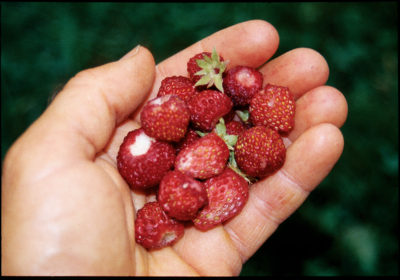
Musk strawberry
Musk strawberry might be the best tasting of all, but yielded very little for me.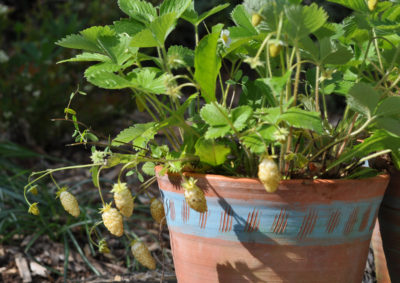
I’ve grown, and still grow, alpine strawberries, white ones that have a pineapple-y flavor and are ignored, because of their lack of color, by birds. The plants are cold-hardy, don’t make runners, and bear all season long. The fruits are a nice, little treat, but not ones with which you’d fill your freezer. For that, the one to plant is some variety of the modern, garden strawberry. I’ll be ordering plants of Earliglow.

